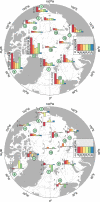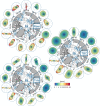Arctic tidal current atlas
- PMID: 32826909
- PMCID: PMC7442801
- DOI: 10.1038/s41597-020-00578-z
Arctic tidal current atlas
Abstract
Tidal and wind-driven near-inertial currents play a vital role in the changing Arctic climate and the marine ecosystems. We compiled 429 available moored current observations taken over the last two decades throughout the Arctic to assemble a pan-Arctic atlas of tidal band currents. The atlas contains different tidal current products designed for the analysis of tidal parameters from monthly to inter-annual time scales. On shorter time scales, wind-driven inertial currents cannot be analytically separated from semidiurnal tidal constituents. Thus, we include 10-30 h band-pass filtered currents, which include all semidiurnal and diurnal tidal constituents as well as wind-driven inertial currents for the analysis of high-frequency variability of ocean dynamics. This allows for a wide range of possible uses, including local case studies of baroclinic tidal currents, assessment of long-term trends in tidal band kinetic energy and Arctic-wide validation of ocean circulation models. This atlas may also be a valuable tool for resource management and industrial applications such as fisheries, navigation and offshore construction.
Conflict of interest statement
The authors declare no competing interests.
Figures






References
-
- Kowalik, Z. & Proshutinsky, A. Y. The Arctic Ocean Tides. The Polar Oceans and Their Role in Shaping the Global Environment1, 137–158 (American Geophysical Union (AGU), 1994).
-
- Proshutinsky A, et al. Sea level variability in the Arctic Ocean from AOMIP models. J. Geophys. Res. Oceans. 2007;112:129.
-
- Luneva MV, Aksenov Y, Harle JD, Holt JT. The effects of tides on the water mass mixing and sea ice in the Arctic Ocean. J. Geophys. Res. Oceans. 2015;120:6669–6699. doi: 10.1002/2014JC010310. - DOI
-
- Padman L, Erofeeva S. A barotropic inverse tidal model for the Arctic Ocean. Geophys. Res. Lett. 2004;31:53–4. doi: 10.1029/2003GL019003. - DOI
-
- Simmons HL, Hallberg RW, Arbic BK. Internal wave generation in a global baroclinic tide model. Deep Sea Research Part II: Topical Studies in Oceanography. 2004;51:3043–3068. doi: 10.1016/j.dsr2.2004.09.015. - DOI
Publication types
Grants and funding
- 1249182/National Science Foundation (NSF)/International
- 1708427/National Science Foundation (NSF)/International
- 1708427/National Science Foundation (NSF)/International
- 294396/Norges Forskningsråd (Research Council of Norway)/International
- 03G0833/Bundesministerium für Bildung und Forschung (Federal Ministry of Education and Research)/International
LinkOut - more resources
Full Text Sources

